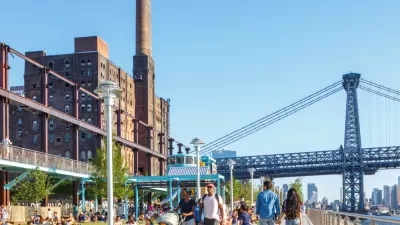Steven Malanga writes about the resurrection of Bushwick, a Brooklyn neighborhood, from its decrepit past.
'These days, when Morris Todash walks the streets of Bushwick, a two-square-mile neighborhood of 100,000 people in central Brooklyn, he likes what he sees. On the long-abandoned seven-acre site of the former Rheingold Brewery, new two-family homes and condominiums have sprung up. On the side streets along Broadway-not so long ago, pockmarked with desolate lots where stray dogs wandered amid burned-out cars-more new homes arise and old ones get impressive face-lifts. New businesses-an organic grocery store, a fashionable restaurant-seem to be opening on every corner. Todash, whose insurance firm has served the neighborhood for more than 40 years, can hardly believe that this is the same Bushwick that became synonymous with urban chaos during the late 1960s and early 1970s, ravaged by fires, rioting, and looting until it resembled a war zone. "When I first came here to open a business, this was a shopping destination for all of Brooklyn," Todash says of the neighborhood's commercial district. "After the looting, no one wanted to come here any more."
Often described by residents as a forgotten neighborhood, Bushwick was once a solid blue-collar community. But starting in the 1960s, a steady barrage of demographic changes and ruinous Great Society policies battered it down. So total was the devastation that even as New York began rebounding in the mid-1990s, Bushwick remained largely untouched by gentrification. Only recently-after years of tireless work by government (especially the police), local groups, and the private sector-has the revitalization of this once-proud neighborhood begun."
FULL STORY: The Death and Life of Bushwick

Alabama: Trump Terminates Settlements for Black Communities Harmed By Raw Sewage
Trump deemed the landmark civil rights agreement “illegal DEI and environmental justice policy.”

Study: Maui’s Plan to Convert Vacation Rentals to Long-Term Housing Could Cause Nearly $1 Billion Economic Loss
The plan would reduce visitor accommodation by 25% resulting in 1,900 jobs lost.

Planetizen Federal Action Tracker
A weekly monitor of how Trump’s orders and actions are impacting planners and planning in America.

Passengers Flock to Caltrain After Electrification
The new electric trains are running faster and more reliably, leading to strong ridership growth on the Bay Area rail system.

Texas Churches Rally Behind ‘Yes in God’s Back Yard’ Legislation
Religious leaders want the state to reduce zoning regulations to streamline leasing church-owned land to housing developers.

Grand Rapids Mayor Proposes Garage Conversion Plan
The mayor says allowing homeowners to convert garages to dwelling units could alleviate the city’s housing shortage.
Urban Design for Planners 1: Software Tools
This six-course series explores essential urban design concepts using open source software and equips planners with the tools they need to participate fully in the urban design process.
Planning for Universal Design
Learn the tools for implementing Universal Design in planning regulations.
Caltrans
Smith Gee Studio
Institute for Housing and Urban Development Studies (IHS)
City of Grandview
Harvard GSD Executive Education
Toledo-Lucas County Plan Commissions
Salt Lake City
NYU Wagner Graduate School of Public Service



























